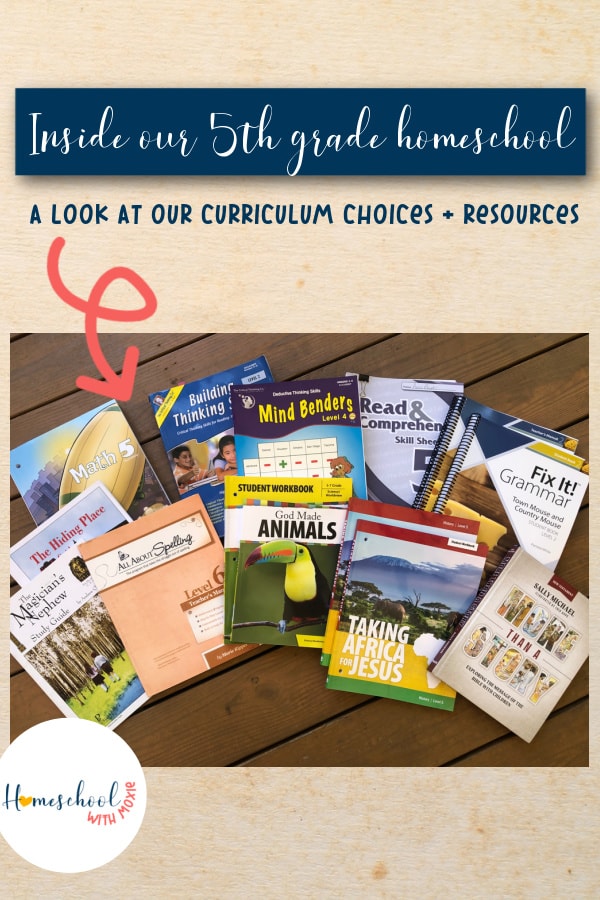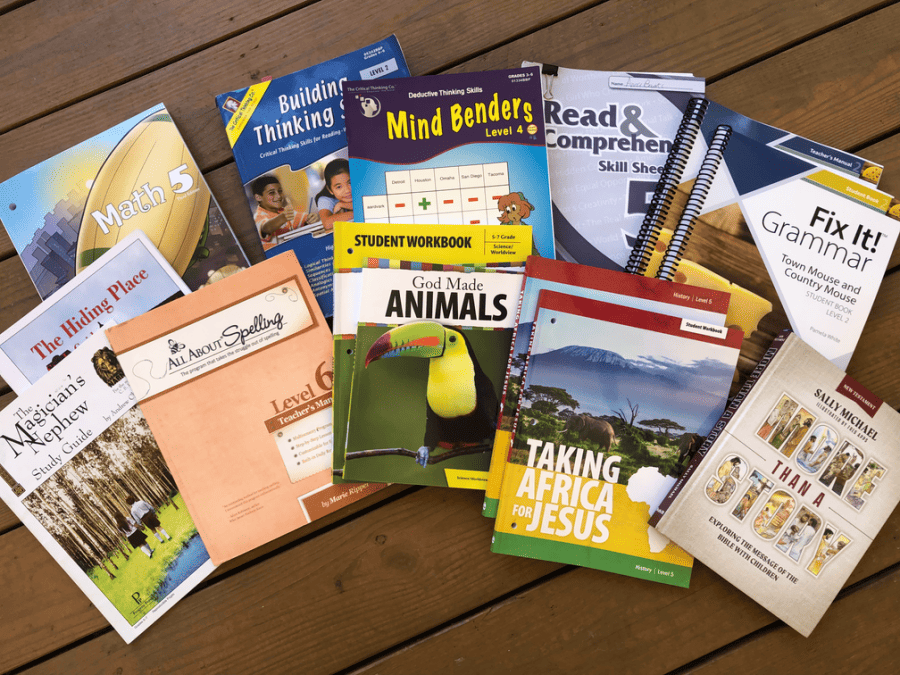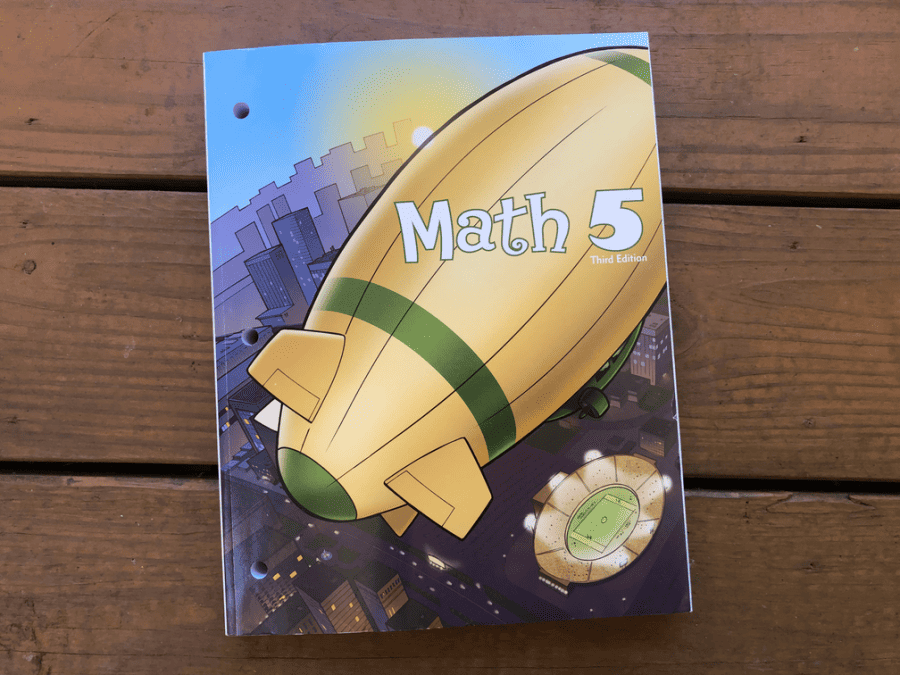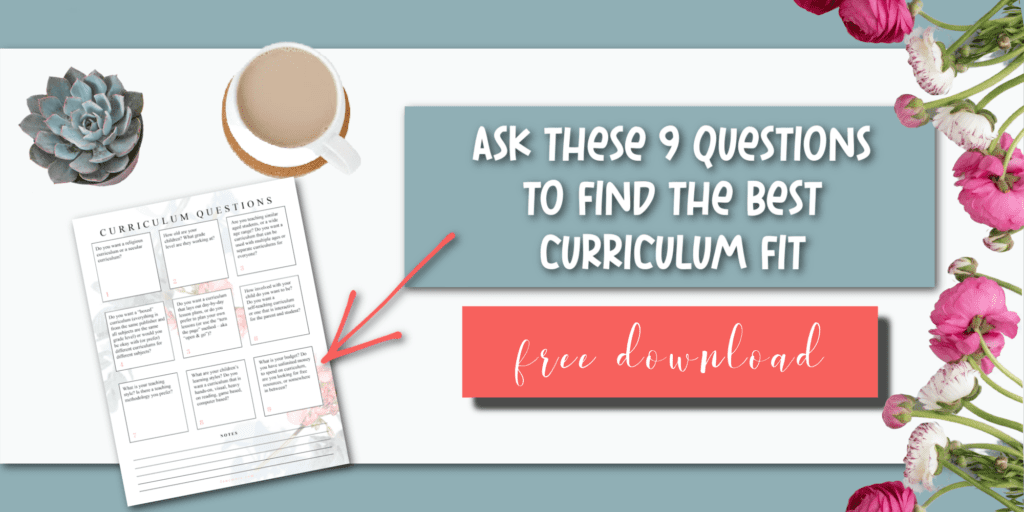It’s 2023 and this fall will be the fifth and final time I homeschool a 5th grader! It’s bittersweet for sure. Some things have remained constant (like BJU Press Math) and many things have changed since I homeschooled my oldest through 5th grade a decade ago. So, here’s a look at our homeschool 5th grade curriculum choices and resources.

My posts contain affiliate links.
Homeschool 5th Grade Curriculum
Are you getting ready to homeschool a 5th grader? In my opinion, these upper elementary and middle school years are some of the richest opportunities for growth. The kids are more independent and capable of critical thinking and discussion. Homeschooling 5th grade can actually be a lot of fun!
But it’s still important to find curriculum that will help foster a love of learning and provide a solid foundation for future academic success. Plus, the style of the curriculum needs to be a good fit for your child and for you as the homeschool parent.
In this post, I’ll give you an inside look into what we’re using this time around. Plus, we’ll address the common questions and concerns that homeschool moms have regarding 5th grade curriculum choices.
The Importance of Choosing the Right Curriculum
You definitely want to find the right balance between structure and accountability and flexibility in the curriculum. And you want to keep in mind that the groundwork you invest in these next several years will set the tone and expectations for the homeschool high school years.
Our curriculum choices have definitely changed since the last time we made a homeschool plan for 5th grade. Remember, there’s no one right curriculum. And you’re allowed to change course over the years. Just because you use one 5th grade resource for an older child doesn’t mean something better won’t come along years later to use for a younger sibling.
Even though I had invested in some other curriculum, I had to be able to let go and use what I believed to be better for this child and for this season of homeschooling.
Of course, keep your child’s learning style, interests, and educational goals in mind when selecting curriculum. One of my favorite places to look for homeschool curriculum reviews is Cathy Duffy Reviews. You can hear Cathy on episode 116 of the Homeschool with Moxie Podcast, where we discuss how to choose homeschool curriculum.

Homeschool 5th Grade Math Curriculum
Here’s our one constant through the elementary years – BJU Press Math! It’s an easy to use, open & go, user-friendly, budget-friendly, solid math curriculum. We don’t buy the teacher’s manual in K-6th grades, just the student worktext. We don’t purchase the additional practice books either.

It’s simple to just do the very next lesson each day. The instruction and teaching is explained at the top of each page with plenty of practice problems below. If my student needs additional practice and work on a concept, they complete the back of the page in part or whole. That’s it!
This student work text includes chapter review and cumulative review pages that you can use for assessment purposes if you choose.
Since we don’t use the teaching videos, teacher’s guide, or anything else to go along with the BJU Press Math Student Worktext, I can even purchase a slightly older edition for very cheap, which is what I ended up doing this year! BJU Press updated their 5th grade math, but there was no reason for me to spend more on the updated edition. I’ve already used this older edition for the last 10 years, and so I found one on eBay for a great price since most people are looking for the newer edition.
Language Arts: Reading, Writing, Spelling, and Grammar
I don’t typically like using an all-in-one language arts curriculum. Instead, I’ve found that choosing a narrowly focused resource for each of the language arts sub-categories works better for us. So, we have a separate curriculum for spelling, reading comprehension, literature studies, grammar, and so on. We’ll do writing across the subject areas as needed.
Spelling
We’ve loved All About Spelling for many years now. And my rising fifth grader is zipping through the program! She’s excited to be in Level 6 of AAS, with only one level to go.
Grammar
Within the last few years, we’ve settled on Fix It! Grammar from IEW as our favorite grammar resource. We’ll be using Level 2 this year. I have the Teacher’s Manual and the Student Book. It only takes a few minutes each day to do a lesson.

About once per week, I talk through the new concepts with my student and make sure they understand. Then, the rest of the week can be done independently. My kids check their own work with the Teacher’s Manual each day for immediate feedback.
If you want to know what level your child should start at, IEW has free lessons to download and gives you a good guide to placement.
Reading Comprehension
I’ve had Read & Comprehend Skill Sheets from A Beka Book in my homeschool library for a while. I think I probably purchased them at a used curriculum sale over a decade ago. My older kids used these, but never wrote on the sheets. This is one way I was able to homeschool on a budget – by not consuming the consumable workbooks! We just used separate paper instead and four other kids have used this book. Now, my fifth and final homeschooler gets to write in the book and use it up.
Literature
When my older kids were young, we did a ton of read-alouds together. Now I felt like my youngest needed a bit more accountability and structure for reading through some classics, so I picked up two literature guides from Progeny Press.
She’ll be reading The Magician’s Nephew and the Hiding Place this year, along with other books for pleasure.
Writing
I’m not too worried about including a formal writing curriculum in the plan this year. We still do lots of oral narration, especially related to literature, Bible, and science and history. Setting that foundation is more important than rushing to write book reports and essays in the elementary years. We will likely add an IEW writing resource next year.
Homeschool 5th grade Science
I took a peek at what we used the last time we had a 5th grader in the house, and it was Apologia’s Physiology book. We actually just used that for her 4th grade year, so we needed something new for 5th grade. And that’s when Generations Homeschool came along and offered us curriculum in exchange for a review.
We’ll be using their elementary science curriculum, God Made Animals, which is geared toward a 5th-7th grade student. We have the main textbook and the Student Workbook.

5th Grade History Curriculum
I’m excited that we’ll be using Generations Homeschool history curriculum for a few years. We’ll start with Taking Africa for Jesus, then move onto Europe and Asia in the next year or so. It’s unusual to find history curriculum that focuses on one continent. And Generations Homeschool history is so unique in that a biblical worldview is not sprinkled throughout the book, but it’s central to the whole focus of the book.
We have the student workbook and the main textbook. You can read our entire review of Generations Homeschool elementary history curriculum to see for yourself how the curriculum is structured.
Bible Curriculum
Since we read through Sally Michael’s More Than a Story Old Testament last year, we’ll be reading the New Testament volume. This Bible reader is at a much deeper and higher level than most kids’ Bible books. It is perfect for the upper elementary ages when the kids are ready for doctrinal discussions, questions that require higher level thinking, and application.
You’ll find multiple questions at the end of every lesson that you can discuss orally or have your child write in a notebook. There are loads of biblical truths and doctrinal topics in bold text that you can also use notebooking to explore. You can choose key verses for Scripture memory.
There are 66 lessons in this book, so if we finish before the end of the year, we’ll likely jump into our James Self Study Workbook – at my daughter’s request! She completed the Little Fishes Bible Studies in previous years and is excited to try the older kids’ studies and get a serious deep dive into an entire book of the Bible.
Electives for 5th Grade Homeschool
Electives are important for enrichment and growth in various other areas not usually covered in the core subjects. You can find electives by using online courses, community programs, or local resources.
Our 5th grade electives include piano lessons, physical education, Building Thinking Skills, Mind Benders, and occasional art.
Common Questions about 5th Grade Homeschool Curriculum
Here are some of the most common questions moms ask about homeschooling 5th grade and finding the right curriculum for their student.
How to Determine the Scope and Sequence
If you’re concerned about staying on track (which you don’t necessarily need to be concerned about because homeschoolers are never behind!), you can do one of several things:
- consult your state department of education website for 5th grade scope and sequence or learning objectives and standards
- ask your local school district for a list of 5th grade standards or learning objectives
- check out What Your 5th Grader Needs to Know and use it as a general guide
How do I figure out my child’s learning style?
This is a great question to ask! Because when you can customize your homeschooling to fit your child’s learning style, you’ll see better engagement and success.
On episode 133 of the Homeschool with Moxie Podcast, we discussed learning styles with Dr. Kathy Koch. From her book 8 Great Smarts, and then 8 Great Smarts for Homeschoolers by Tina Hollenbeck, you’ll learn how to capitalize on your child’s strengths as you homeschool.
How much time should I allocate to each subject in a 5th grade curriculum?
When you’re homeschooling, you have to remember that you are far more efficient than a public or private school classroom teacher who has dozens of students. Your 5th grader likely will be done with everything within a few hours!
Unless your state requires you to homeschool for a certain number of hours (and most states do not), then you don’t need to give a strict time limit to each subject. Just do the next lesson for most subjects each day. If you have a field trip day, or an errand day, or go to the library, then just cut back on the regular book work you require.
Here’s a more thorough discussion about how long does homeschooling take?
Can I customize curriculum? How do I do that?
Yes! You can and should customize curriculum. Remember that the curriculum is just a guide – you are in charge. That means you don’t ever have to do everything a curriculum recommends. You also don’t have to finish a curriculum.
Some ways to customize curriculum include:
- letting your child orally answer questions or use narration instead of workbook pages or printables
- ditching the workbooks and using notebooking instead
- learning about your child’s strengths and tailoring your homeschool teaching and learning around them
- use audio books and resources if your child is an auditory learner or has dyslexia
- integrate lots of hands-on learning for your kinesthetic and younger learners
How can I integrate hands-on activities into a 5th grade homeschool curriculum?
Instead of relying on a textbook or student workbook to do all the teaching, get your students actively participating in their studies. Here are some easy ways to do that:
- science experiments
- field trips (history comes alive!)
- inductive Bible study
- gardening and nature exploration
- cooking
- building models
- notebooking
- using math manipulatives
- math applicational real-world problems
How can I find budget-friendly 5th grade homeschool curriculum choices?
You really can homeschool on a budget! Use the library, borrow from friends, buy used, and piece together your own resources instead of buying a complete grade level of curriculum in order to save money.
Do I need to assign grades in 5th grade?
My personal opinion is that you don’t need to assign grades in 5th grade. There’s no point to it really, because you know at any day in the school year how your child is doing. You likely are not required to turn in grades to your state (consult your state homeschool law at HSLDA), so you don’t need to assign grades.
If you’re teaching for mastery, you wouldn’t keep pushing your child forward if they didn’t understand. So, hypothetically, all our homeschooled kids are mastering the material before moving forward.
Now, in the high school years when you need to start to compile their grades on a transcript, then things will change. But for now, you probably don’t need to assign grades and you can track their progress organically.
How can I assess my child’s progress and track their learning within a 5th grade homeschool curriculum?
When you’re homeschooling, you can (and should) give close to immediate feedback on assignments. That way, your child can correct their answers and misunderstanding of the material before moving on.
If you want a way to keep them on task during the day and understand what needs to be accomplished, you could set up a workbox system or use Trello.
Listen to the Homeschool with Moxie Podcast
On episode 217, we’ll talk through these homeschool 5th grade curriculum choices.
Final Thoughts on Homeschool 5th Grade Curriculum
Remember that I’m sharing our 5th grade homeschool curriculum choices as a way to give you ideas and perhaps show you resources you hadn’t known about. That’s not to say that all of our choices will work beautifully for your kids! Remember that your kids are unique and you need to adapt your curriculum choices to meet your child’s individual needs along with your budget and homeschooling style.
Don’t forget to check out Cathy Duffy Reviews!
Of course, keep in mind your main goals of customizing your child’s education, having flexibility in your daily schedule, fostering a love of learning with your kids, and being their chief discipling and worldview influence.

